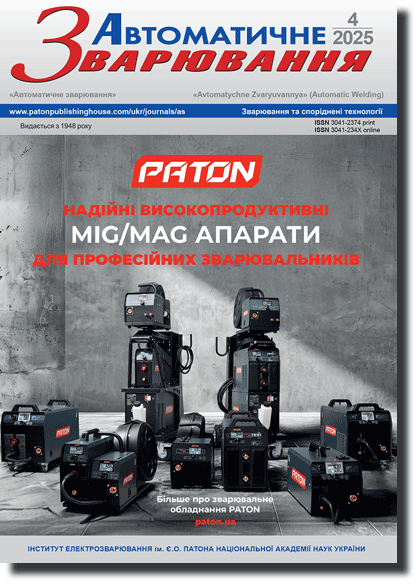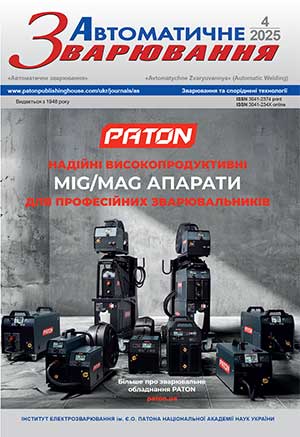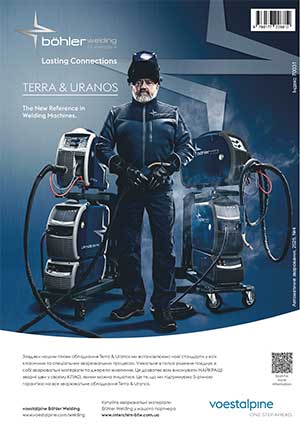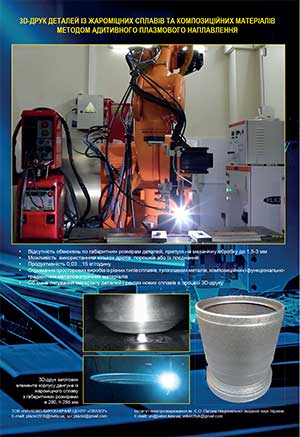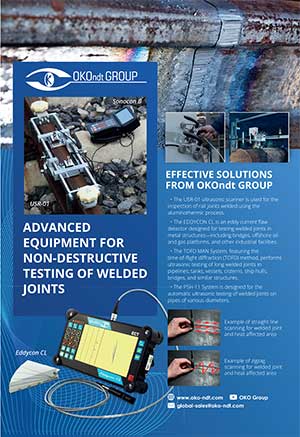| 2025 №04 (09) |
DOI of Article 10.37434/as2025.04.01 |
2025 №04 (02) |
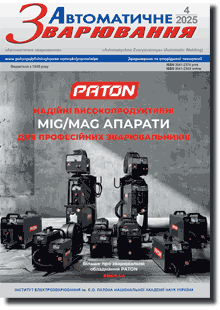
"Avtomatychne Zvaryuvannya" (Automatic Welding), #4, 2024, pp. 3-10
Electrodynamic treatment to control residual stresses in welded joints made of light heat-resistant alloys and austenitic steel
L.M. Lobanov, M.O. Pashchyn, O.L. Mikhodui, O.M. Tymoshenko
E.O. Paton Electric Welding Institute of the NAS of Ukraine 11 Kazymyr Malevych Str., 03150, Kyiv, Ukraine. E-mail: olha.mikhodui@gmail.comThe technology of electrodynamic treatment (EDT) of prototypes of thin-sheet butt welded joints of Al, Ni, Ti alloys and austenitic steel was developed and implemented. Specialized assembly tooling was designed, which was used to perform automatic TIG welding of the prototypes. The effect of EDT on residual stresses in welded joint samples was studied using the electron speckle interferometry method. It was found that EDT is an effective mechanism for controlling the residual stressed states of welded joints of Al and Ti alloys and austenitic steel. It is shown that to improve the efficiency of EDT of a Ni-based alloy, it is necessary to use higher values of electrodynamic action energy in the framework of further research. It is also advisable to use a new processing method based on magnetic pulse effects on nonferromagnetic materials to optimize the residual stressed states of welded joints of Ni-based alloys. 19 Ref., 8 Tabl., 11 Fig.
Keywords: Al, Ni, Ti based alloys, austenitic steel, electrodynamic processing, transport structures, welded joints, electron speckle interferometry, residual stressed states, mechanical characteristics, chemical composition, processing efficiency, residual stress control
Received: 15.04.2025
Received in revised form: 23.06.2025
Accepted: 05.08.2025
References
1. Masubuchi, K. (1980) Analysis of welded structures. Oxford, Pergamon Press.2. Razmyshlyaev, A.D., Ageeva, M.V. (2018) On mechanism of weld metal structure refinement in arc welding under action of magnetic fields (Review). The Paton Welding J., 3, 25-28. https://doi.org/10.15407/tpwj2018.03.05
3. Dubodelov, V.I., Goryuk, M.S. (2018) Application of electromagnetic fields and magnetohydrodynamic phenomena to intensify the effect on metal systems: World and Ukrainian experience. Nauka pro Materialy: Dosiahnennia ta Perspektyvy. In 2 vols. Vol. 2. Kyiv, Akademperiodyka, 24-50 [in Ukrainian].
4. Volkogon, V.M., Avramchuk, S.K., Strilets, E.V. (2005) Formation of hardening coatings under the action of powerful electric discharge. In: Proc. of 5th Intern. Sci. and Techn. Conf. on Surface Engineering and Renovation of Products, 21-24 May 2005, Yalta, 48-51 [in Russian].
5. Conrad, H., Sprecher, A. (1989) The electroplastic effect in metals. Ed. by F.R.N. Nabarro. Elsevier Sci. Publ. B.V., Dislocations in Solids, 500-529.
6. Baranov, Y.V., Troitskiy, O.A., Avramov, Y.S. (2001) Physical bases of electroimpulse and electroplastic processing and new materials. Moscow, MGIU [in Russian].
7. Stepanov, G.V., Babutskii, A.I., Mameev, I.A. (2004) High-density pulse current-induced unsteady stress-strain state in a long rod. Strength of Materials, 36, 377-381. https://doi.org/10.1023/B:STOM.0000041538.10830.34
8. Gu, S., Kobayashi, D., Yan et al. (2024) Achieving stress relief in martensitic stainless steel via high-density pulsed electric current treatment. Metallurg. and Mater. Transact. A: Physical Metallurgy and Materials Sci., 55(10), 3859-3868. https://doi.org/10.1007/s11661-024-07522-5
9. Zhang, X., Xiang, S., Yi, K., Guo, J. (2022) Controlling the residual stress in metallic solids by pulsed electric current. Acta Metallurgica Sin., 58(5), 581-598.
10. Lobanov, L.M., Pashchin, N.A., Yashchuk, V.A., Mikhodui, O.L. (2015) Effect of electrodynamic treatment on the fracture resistance of the AMg6 aluminum alloy under cyclic loading. Strength of Materials, 47, 447-453. https://doi.org/10.1007/s11223-015-9676-5
11. Liu, C., Wang, M., Peng, H. et al. (2024) Pulse electric current induced interfacial ductile phase on improving the mechanical properties of the Au20Sn/Cu solder joints. J. of Materials Sci.: Materials in Electronics, 35(18), 1210. https://doi.org/10.1007/s10854-024-13002-8
12. Strizhalo V.A., Novogrudskiy L.S., Vorobyev E.V. (2008) Strength of materials at cryogenic temperatures with account for the effect of electromagnetic fields. Kyiv, ISP [in Russian].
13. Pashchin, N.A., Zarutskiy, A.V. (2016) Influence of electrodynamic material treatment on fatigue life of samples with holes. In: Intern. Sci. and Techn. Conf. on Problems of Creation and Maintenance of the Life Cycle of Aviation Equipment, Kharkiv, 20-21 April 2016, 16 [in Russian].
14. Lobanov, L.M., Pashchin, N.A., Cherkashin, A.V. et al. (2012) Repair welding of intermediate cases of aircraft engines from high-temperature magnesium alloy ML10 with application of electrodynamic treatment. The Paton Welding J., 11, 28-32.
15. Lobanov, L.M., Pashchin, N.A., Loginov, V.P. et al. (2010) Repair of ship hull structures of aluminium alloy AMg6 using electrodynamic treatment. The Paton Welding J., 9, 31-32.
16. Lobanov, L.M., Korzhyk, V.M., Pashchyn, M.O. et al. (2022) Deformation-free TiG welding of AMg6 alloy with application of electrodynamic treatment of weld metal. The Paton Welding J., 8, 3-8. https://doi.org/10.37434/tpwj2022.08.01
17. Lobanov, L.M., Pashchyn, M.O., Mikhodui, O.L. et al. (2022) Stress-strain state of welded joints of AMg6 alloy after electrodynamic treatment during welding. Strength of Materials, 54(6), 983-996. https://doi.org/10.1007/s11223-023-00474-y
18. Lobanov, L.M., Pivtorak, V.A., Savitsky, V.V., Tkachuk, G.I. (2006) Procedure for determination of residual stresses in welded joints and structural elements using electron speckle interferometry. The Paton Welding J., 1, 24-29.
19. Vinokurov, V.A. (1968) Welding deformations and stresses. Moscow, Mashinostroenie [in Russian].
Advertising in this issue:
To order the electronic version of the paper:
L.M. Lobanov, M.O. Pashchyn, O.L. Mikhodui, O.M. TymoshenkoElectrodynamic treatment to control residual stresses in welded joints made of light heat-resistant alloys and austenitic steel
Automatic Welding №04 2025 p.3-10
The cost of article (pdf): 13 $, 12 €, 150 UAH (1 copy. )
fill in the form below:
The cost of subscription/purchase order journals or individual articles
| Journal/Currency | Annual Set | 1 issue printed |
1 issue |
one article |
| TPWJ/USD | 384 $ | 32 $ | 26 $ | 13 $ |
| TPWJ/EUR | 348 € | 29 € | 24 € | 12 € |
| TPWJ/UAH | 7200 UAH | 600 UAH | 600 UAH | 280 UAH |
| AS/UAH | 1800 UAH | 300 UAH | 300 UAH | 150 UAH |
| AS/USD | 192 $ | 32 $ | 26 $ | 13 $ |
| AS/EUR | 180 € | 30 € | 25 € | 12 € |
| SEM/UAH | 1200 UAH | 300 UAH | 300 UAH | 150 UAH |
| SEM/USD | 128 $ | 32 $ | 26 $ | 13 $ |
| SEM/EUR | 120 € | 30 € | 25 € | 12 € |
| TDNK/UAH | 1200 UAH | 300 UAH | 300 UAH | 150 UAH |
| TDNK/USD | 128 $ | 32 $ | 26 $ | 13 $ |
| TDNK/EUR | 120 € | 30 € | 25 € | 15 € |
AS = «Automatic Welding» - 6 issues per year;
TPWJ = «PATON WELDING JOURNAL» - 12 issues per year;
SEM = «Electrometallurgy Today» - 4 issues per year;
TDNK = «Technical Diagnostics and Non-Destructive Testing» - 4 issues per year.





